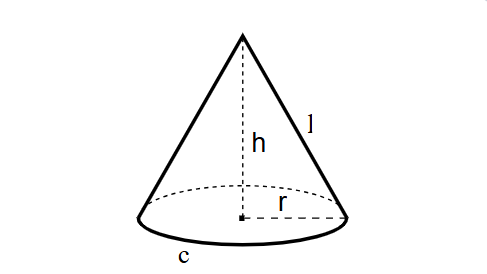1. What is a Cone Surface Area Calculator?
Definition: This calculator computes the circumference (\( c \)) of the base, slant height (\( l \)), and total surface area of a right circular cone, given the radius (\( r \)) of the base and the height (\( h \)). A right circular cone is a three-dimensional shape with a circular base and a single vertex, where the axis is perpendicular to the base.
Purpose: It aids in geometry education, engineering, and design by calculating key parameters for applications like manufacturing (e.g., conical containers), architecture (e.g., conical roofs), and material estimation.
2. How Does the Calculator Work?
The calculator takes the radius (\( r \)) and height (\( h \)) with independently selected units (m, cm, mm, in, ft, yd) and computes:
- Circumference (\( c \)):
- Formula: \( c = 2 \pi r \).
- The circumference of the cone’s circular base.
- Slant Height (\( l \)):
- Formula: \( l = \sqrt{r^2 + h^2} \).
- The distance from the vertex to a point on the base’s circumference, forming a right triangle with the radius and height.
- Surface Area:
- Formula: \( A = \pi r^2 + \pi r l \).
- Sum of the base area (\( \pi r^2 \)) and the lateral surface area (\( \pi r l \)).
Unit Conversions:
- Length Units: m, cm (1 m = 100 cm), mm (1 m = 1000 mm), in (1 m = 39.3701 in), ft (1 m = 3.28084 ft), yd (1 m = 1.09361 yd).
- Area Units: m², cm² (1 m² = 10000 cm²), mm² (1 m² = 1000000 mm²), in² (1 m² = 1550.0031 in²), ft² (1 m² = 10.7639 ft²), yd² (1 m² = 1.19599 yd²).
Steps:
- Input the radius (\( r \)) and height (\( h \)) with their respective units.
- Validate inputs (\( r > 0 \), \( h > 0 \)).
- Convert inputs to meters for calculations.
- Compute circumference, slant height, and surface area.
- Convert each result to its independently selected output unit and format to 4 decimal places or scientific notation for small values.
3. Importance of Cone Surface Area Calculations
Calculating cone parameters is crucial for:
- Geometry Education: Understanding the properties of three-dimensional shapes.
- Engineering and Manufacturing: Designing conical objects like funnels, lampshades, or traffic cones, and estimating material needs.
- Architecture: Creating structures with conical elements, such as spires or roofs.
4. Using the Calculator
Examples:
- Example 1: Radius \( r = 5 \, \text{cm} \), Height \( h = 12 \, \text{cm} \), Output units: cm, cm, cm²
Convert: \( r = 0.05 \, \text{m} \), \( h = 0.12 \, \text{m} \).
Circumference: \( c = 2 \pi \times 0.05 \approx 0.3142 \, \text{m} = 31.4159 \, \text{cm} \).
Slant Height: \( l = \sqrt{0.05^2 + 0.12^2} \approx 0.1300 \, \text{m} = 13.0000 \, \text{cm} \).
Surface Area: \( A = \pi \times 0.05^2 + \pi \times 0.05 \times 0.1300 \approx 0.0204 \, \text{m}^2 = 204.2035 \, \text{cm}^2 \).
- Example 2: Radius \( r = 3 \, \text{m} \), Height \( h = 4 \, \text{m} \), Output units: m, ft, m²
Circumference: \( c = 2 \pi \times 3 \approx 18.8496 \, \text{m} \).
Slant Height: \( l = \sqrt{3^2 + 4^2} = 5.0000 \, \text{m} = 16.4042 \, \text{ft} \).
Surface Area: \( A = \pi \times 3^2 + \pi \times 3 \times 5 \approx 75.3982 \, \text{m}^2 \).
- Example 3: Radius \( r = 10 \, \text{in} \), Height \( h = 24 \, \text{cm} \), Output units: mm, in, in²
Convert: \( r = 0.2540 \, \text{m} \), \( h = 0.24 \, \text{m} \).
Circumference: \( c \approx 1.5959 \, \text{m} = 1595.9448 \, \text{mm} \).
Slant Height: \( l \approx 0.3516 \, \text{m} = 13.8438 \, \text{in} \).
Surface Area: \( A \approx 0.2759 \, \text{m}^2 = 427.5849 \, \text{in}^2 \).
5. Frequently Asked Questions (FAQ)
Q: What is a right circular cone?
A: A right circular cone is a three-dimensional shape with a circular base and a single vertex, where the axis from the vertex to the center of the base is perpendicular to the base.
Q: Why is the slant height needed for surface area?
A: The slant height is the distance from the vertex to a point on the base’s circumference, used to calculate the lateral surface area of the cone, which is combined with the base area to find the total surface area.
Q: Can I use different units for inputs and outputs?
A: Yes, the calculator allows independent unit selection for radius, height, circumference, slant height, and surface area, enabling flexible conversions (e.g., radius in meters, height in centimeters, surface area in square inches).
 Home
Home
 Back
Back
